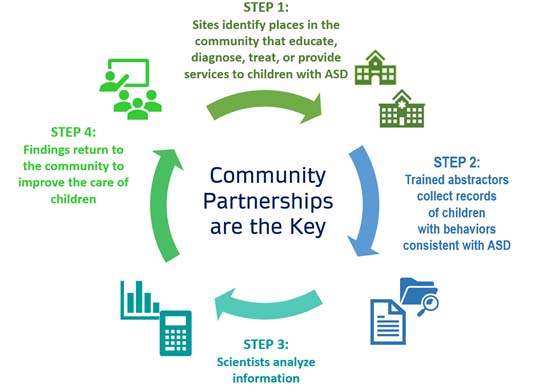Tracking Methods for Autism Spectrum Disorder
The Autism and Developmental Disabilities Monitoring (ADDM) Network is the only collaborative network to track the number and characteristics of children with autism spectrum disorder (ASD) in multiple communities in the United States. Since the launch of the ADDM Network in 2000, CDC has funded 17 sites in areas of Alabama, Arizona, Arkansas, California, Colorado, Florida, Maryland, Minnesota, Missouri, New Jersey, North Carolina, Pennsylvania, South Carolina, Tennessee, Utah, West Virginia, and Wisconsin. CDC also operates an additional ADDM site in Georgia. The ADDM Network tracks more than 220,000 8-year-old children and 220,000 4-year-old children. The ADDM Network is following-up on a cohort of 16-year-old children in select states.
The ADDM Network’s goals are to
- Obtain as complete a count as possible of the number of 8-year-old and 4-year-old children with ASD in each ADDM Network area and identify changes in that count over time;
- Provide information about early identification of children with ASD, including ages of evaluation and diagnosis;
- Describe health and service needs of adolescents with ASD;
- Provide information on the characteristics of children with ASD, including sex, race/ethnicity, co-occurring intellectual ability;
- Determine whether ASD is more common in some groups of children (for example, among boys versus girls) than among others, and if those differences are changing over time; and
- Understand the impact of ASD and related conditions upon children, families, and communities in the United States.
How does ADDM develop estimates?
ADDM Network Sites estimate the number of children with ASD within their respective state or territory using a record review method to find children who have received an ASD diagnosis, an autism special educational classification, or an ASD International Classification of Diseases (ICD) code from a community health or education service provider. Additional information is collected from records to provide information about demographic characteristics and other important health conditions, like co-occurring intellectual disability.

How does ADDM access data?
ADDM Network Sites access data through written agreements with state health departments, school districts, and early intervention providers. In 2020, the U.S. Department of Education’s Office of Special Education Programs, Office of the General Counsel, and Office of Special Education and Rehabilitation Services worked with CDC to create a data agreement form that can be used by currently funded ADDM Network sites to access state education records. This important agreement helps ADDM to provide more complete ASD estimates.
What are the different ways of estimating the number of children with ASD?
There are several different ways to estimate the number of children with ASD, and each method has its advantages and disadvantages.
| Method | What Is It? | Advantages and Disadvantages |
|---|---|---|
| Population-based screening and evaluation | Screening and evaluating a sample of all children in a population, within a defined age group. | Can provide high accuracy, but can be costly and time-consuming, and might produce skewed results based on who agrees to participate. |
| National surveys | Collecting information via standardized instruments, such as telephone interviews or self-completed questionnaires. | Is representative of national characteristics, but might reflect bias based on who participates and how ASD is defined and reported. |
| Registries | Collecting information on children and families who voluntarily include themselves on a list of people affected by ASD. | Relatively low cost, but time-consuming and includes only individuals with a clear diagnosis and families who know about the registry and are willing to be on the list. |
| Administrative data | Looking at codes for services in records from Medicaid and agencies, such as the U.S. Department of Education. | Relatively low cost, but can underestimate prevalence because not all children with ASD are receiving services for ASD or have been diagnosed with ASD. |
| Systematic record review (ADDM Network’s Method) | Linking and reviewing health, service, and special education records to identify and describe characteristics of children with ASD. | Relatively low cost, but challenging to link children across multiple data sources, as all children with ASD may not be identified by a single provider or data source. |
What are the advantages of the ADDM Network method?
There are several major advantages to using the ADDM Network method for tracking the number and characteristics of children with ASD. For example, the ADDM Network
- Is the largest, ongoing ASD tracking system in the United States;
- Uses a method that is population-based, which means we try to identify all the children with ASD from the entire population of children in a defined geographic area (or multiple geographic areas);
- Can track changes over time within different communities and within different groups (such as racial/ethnic groups); and
- Collects and links information from multiple sources in the community where children are served, including schools, local clinics, and service providers.
For the younger population, the ADDM Network tracks children who are at high risk for ASD based on a community provider’s suspicion that ASD is present.
ADDM Network Sites
See a complete list of current Autism and Developmental Disabilities Monitoring (ADDM) Network Sites.